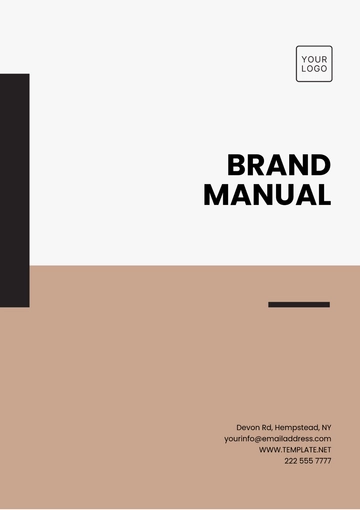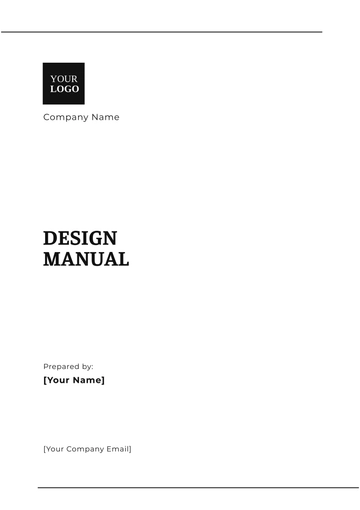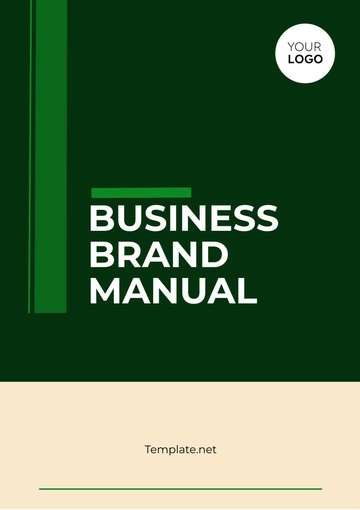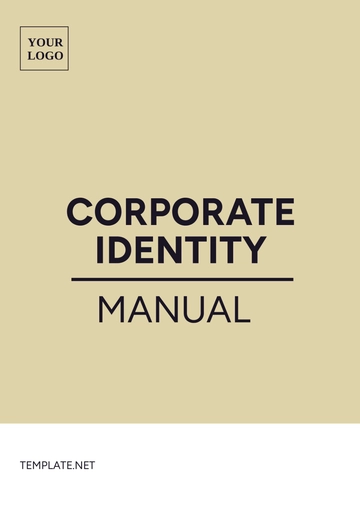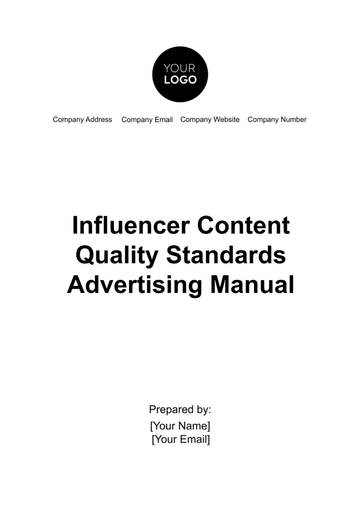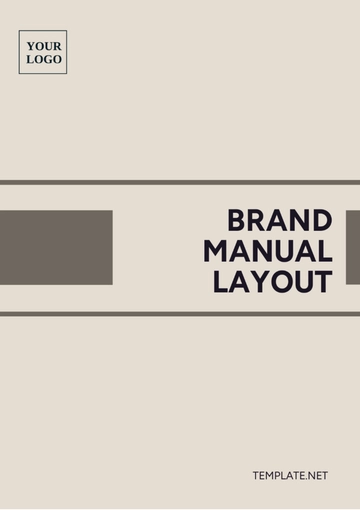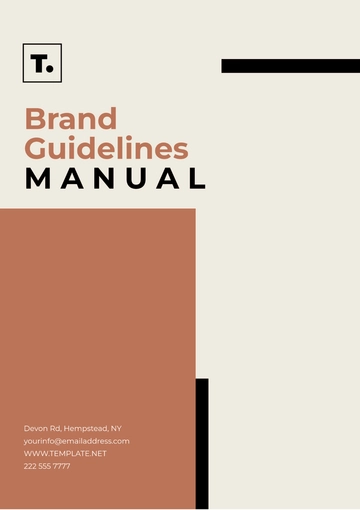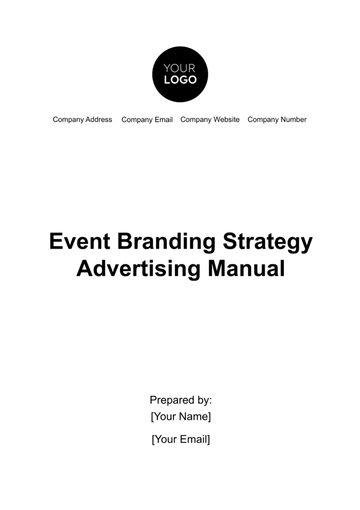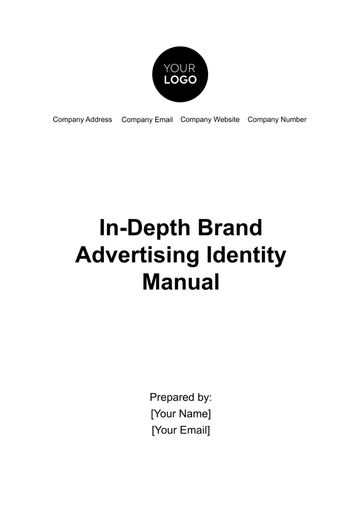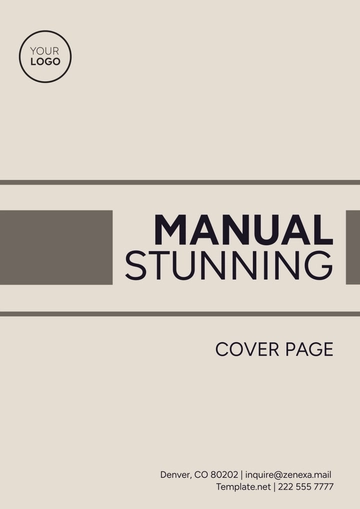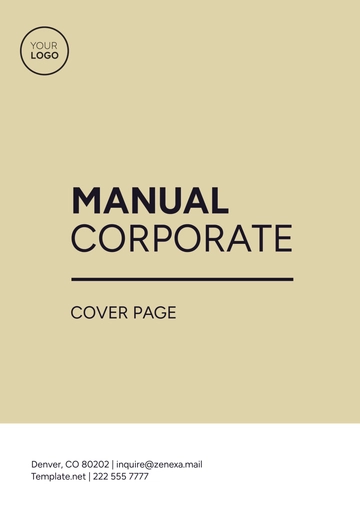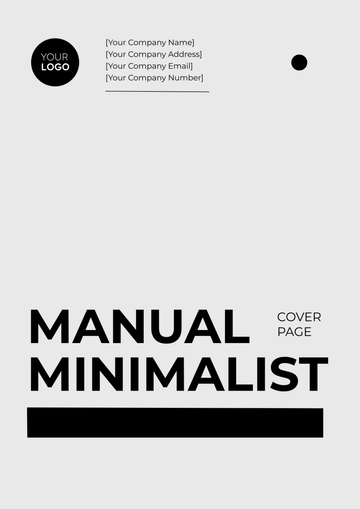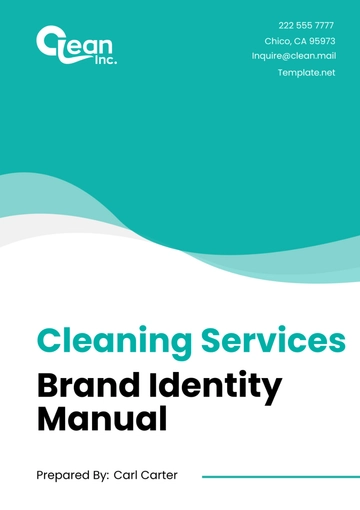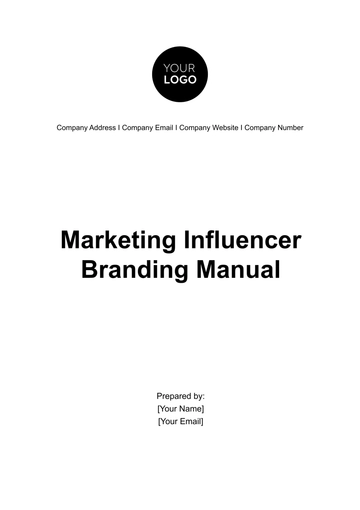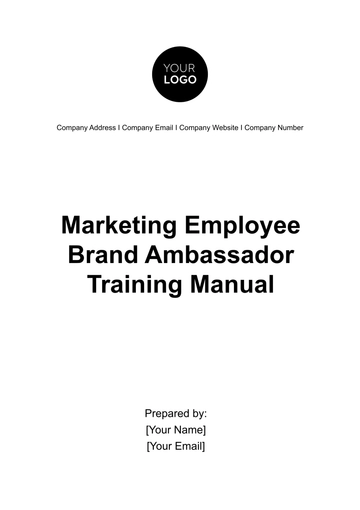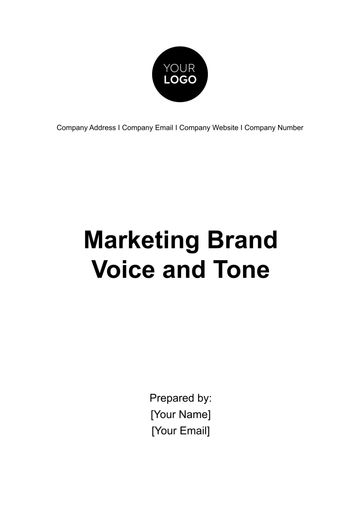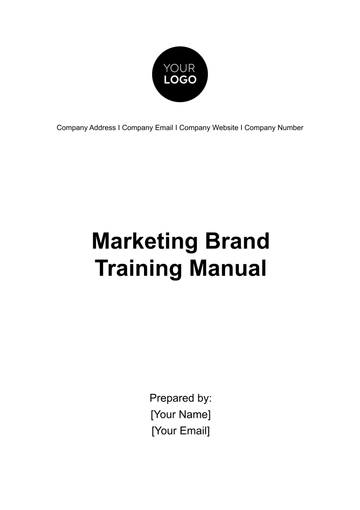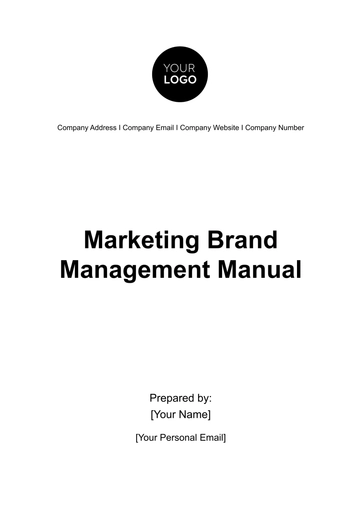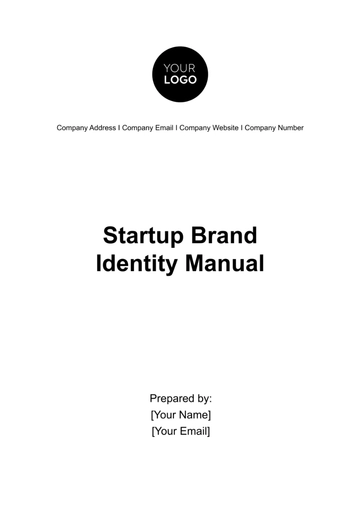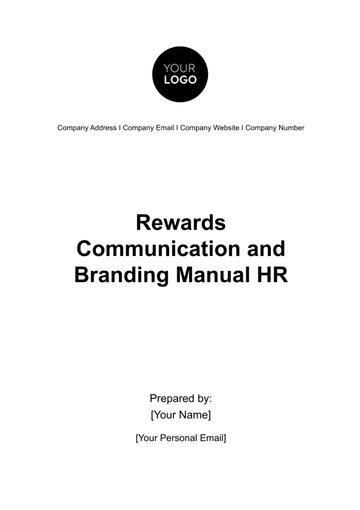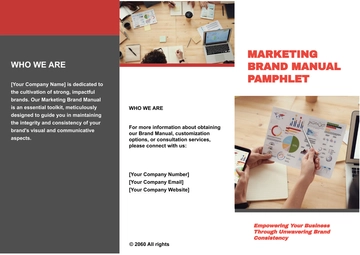Free In-Depth Brand Advertising Identity Manual

1. Introduction
Welcome to the [Your Company Name] Brand Advertising Identity Manual, a definitive guide to maintaining the integrity, consistency, and impact of our brand across diverse communication channels.
A. Purpose
This comprehensive manual is designed to ensure that every interaction, communication, and representation of [Your Company Name] aligns seamlessly with our brand's ethos, values, and vision. It serves as a foundational resource for all team members, agencies, partners, and affiliates who contribute to or engage in creating content, advertising, or communications on behalf of [Your Company Name].
B. Importance of Brand Consistency
At [Your Company Name], we understand that a strong, consistent brand identity is fundamental to our success. Consistency fosters recognition, trust, and loyalty among our audience. It helps us stand out in a crowded marketplace, resonating with our customers and stakeholders on a deeper level.
C. How to Use This Manual
This manual is organized into sections that detail every aspect of our brand identity, from the usage of our logo and color palette to our voice and tone in communication. Each section provides clear guidelines, examples, and best practices to ensure uniformity and clarity in our brand representation.
D. Our Commitment to Excellence
[Your Company Name] is committed to maintaining a high standard of excellence in all our communications. This manual is a living document, subject to periodic updates and improvements as our brand evolves. We encourage feedback, suggestions, and adherence to these guidelines to ensure we collectively reinforce [Your Company Name]'s identity and message.
E. Acknowledgment
This manual is the culmination of collaborative efforts by our branding and marketing teams, drawing upon extensive research, industry best practices, and our unique brand story. We express our gratitude to everyone involved in shaping and refining our brand identity.
2. Business Goals and Objectives
The objectives of our advertising campaign are carefully designed to ensure that [Your Company Name] not only meets but exceeds its growth and engagement goals in the year 2050. These objectives serve as milestones guiding our strategies and efforts throughout the campaign.
2.1. Establishing Brand Consistency
Goal: Ensure a cohesive and recognizable brand identity across all touchpoints.
Objective: Define clear guidelines for the consistent use of logos, colors, typography, and imagery to reinforce [Your Company Name]'s visual identity.
2.2. Communicating Brand Values
Goal: Convey [Your Company Name]'s core values and mission through every communication.
Objective: Develop voice, tone, and messaging guidelines that align with our values and resonate with our target audience.
2.3. Facilitating Collaborative Efforts
Goal: Enable all stakeholders, team members, agencies, and partners to effectively represent [Your Company Name].
Objective: Provide a comprehensive resource that educates and guides individuals involved in creating content or communicating on behalf of [Your Company Name].
2.4. Ensuring Adaptability Across Platforms
Goal: Maintain consistency while adapting to various mediums and platforms.
Objective: Offer specific instructions and adaptable design templates for different advertising channels, including digital, print, social media, and more.
2.5. Encouraging Brand Evolution
Goal: Support the evolution of [Your Company Name]'s brand identity in a controlled and purposeful manner.
Objective: Establish the manual as a living document, subject to periodic updates and improvements based on brand growth, market trends, and feedback.
3. Voice and Tone Guidelines
[Your Company Name]'s voice is the embodiment of professionalism, innovation, and approachability. It's the cornerstone of our communication, resonating with our audience and reflecting our brand's ethos. Here, we explore how our brand's voice adapts to different scenarios, platforms, and audiences while maintaining a coherent and recognizable tone.
3.1. Voice
3.1.1 Professionalism:
[Your Company Name]'s voice is professional, conveying expertise and reliability.
Use clear and concise language without being overly formal.
3.1.2 Innovation:
Emphasize innovation and forward-thinking in our communication.
Encourage a sense of excitement and curiosity about technological advancements.
3.1.3 Approachability:
Maintain an approachable tone to connect with our audience.
Balance professionalism with warmth and friendliness.
3.2. Tone
3.2.1 Adaptability:
Tailor the tone based on the context and audience while maintaining our brand's voice.
Adjust the tone to suit different platforms, such as being more conversational on social media and more authoritative in technical documentation.
3.2.2 Empowerment:
Empower our audience with information and solutions.
Use language that inspires confidence and encourages action.
3.2.3 Clarity:
Ensure clarity in communication by avoiding jargon and complexity.
Use straightforward language to convey our messages effectively.
3.3. Examples
3.3.1 Social Media:
Tone should be conversational, engaging, and reflective of current trends.
Encourage interaction and discussion among followers.
3.3.2 Technical Documentation:
Tone should be authoritative and precise, focusing on clarity and accuracy.
Use industry-specific terminology where necessary but provide explanations for accessibility.
3.3.3 Marketing Materials:
Tone should be persuasive, showcasing the benefits of our products/services.
Use language that evokes emotion and resonates with the audience's aspirations.
3.4. Dos and Don'ts
3.4.1 Do:
Do engage in meaningful conversations with our audience.
Do maintain a consistent voice across all communication channels.
3.4.2 Don't:
Don't use language or tone that contradicts our brand values.
Don't compromise clarity and professionalism for the sake of being casual.
Messaging Framework
At [Your Company Name], every word and phrase is carefully chosen to convey our commitment to innovation, empowerment, and future-focused technology. This framework encapsulates our brand essence. This section provides a structured approach to articulate [Your Company Name]'s story, taglines, and messaging across diverse channels, ensuring a unified and compelling narrative.
4.1. Core Messages
4.1.1 Innovation:
[Your Company Name] is committed to pioneering innovation in technology.
Example: "At [Your Company Name], innovation isn't just a goal; it's in our DNA. We lead the way in technological advancements."
4.1.2 Empowerment:
Empowering individuals and businesses with cutting-edge solutions.
Example: "We believe in empowering our users with tools that drive success and innovation."
4.1.3 Future-Focused:
Constantly evolving and envisioning the future of technology.
Example: "The future is ours to create. [Your Company Name] is shaping tomorrow's technological landscape."
4.2. Taglines and Key Phrases
4.2.1 Elevating Innovation:
Example: "[Your Company Name]: Elevating Innovation Every Step of the Way."
4.2.2 Empowering Tomorrow:
Example: "Empowering Tomorrow's Solutions Today with [Your Company Name]."
4.2.3 Technology Redefined:
Example: "[Your Company Name]: Where Technology is Redefined."
4.3. Targeted Messaging
4.3.1 B2B Messaging:
Focus on how [Your Company Name]'s solutions drive efficiency and growth for businesses.
Example: "[Your Company Name]'s enterprise solutions revolutionize operations, boosting productivity and profitability."
4.3.2 B2C Messaging:
Emphasize how [Your Company Name]'s products enhance individuals' lives and experiences.
Example: "Elevate your daily routines with user-friendly, innovative tech from [Your Company Name]."
5. Guidelines for Different Platforms
This segment within [Your Company Name]'s Brand Advertising Identity Manual provides a comprehensive set of instructions and recommendations for adapting and presenting the [Your Company Name] brand consistently across diverse communication platforms. It emphasizes the importance of aligning the brand's visual and messaging elements with each platform's specific requirements while ensuring coherence with [Your Company Name]'s overarching identity.
5.1 Social Media Platforms
5.1.1 Facebook:
Profile Picture: Dimensions of 180x180 pixels; guidelines to ensure the logo is clearly visible and aligned with brand colors.
Cover Photo: Recommended size of 820 x 312 pixels; instructions for featuring [Your Company Name]'s tagline or key visuals aligned with the brand.
5.1.2 Post Formatting:
Text Length: Suggestions to keep text concise, engaging, and informative within 80-100 characters for optimal engagement.
Image/Video Posting: Guidelines for image/video aspect ratios, file sizes, and content types resonating with [Your Company Name]'s brand story.
5.1.3 Video/Image Content Guidelines:
Video Content: Recommendations for video duration, storytelling approaches, and branding elements (e.g., logo watermark) for consistent visual representation.
Image Content: Instructions for high-resolution images, suggested image sizes, and styles consistent with [Your Company Name]'s visual identity.
5.2 Digital Advertising Platforms
5.2.1 Google Ads:
Dimensions: Recommended sizes for responsive display ads (e.g., 300x250, 728x90, 300x600) ensuring brand elements are prominent and legible.
Imagery and Text: Instructions for including [Your Company Name]'s logo, compelling visuals, and concise text aligned with the brand voice.
5.2.2 Text Ads:
Ad Copy: Guidance for crafting impactful headlines and descriptions within character limits that capture [Your Company Name]'s value proposition.
5.3 Print Media
5.3.1 Magazines/Newspapers:
Best Practices: Suggestions for strategic ad placement within publications, utilizing [Your Company Name]'s brand colors and imagery for maximum impact.
Color Profiles: Instructions for CMYK color mode and specific color codes aligned with [Your Company Name]'s brand palette.
Font Styles: Recommendations for legible font styles and sizes for print ads, maintaining brand consistency and readability.
5.3.2 Brochures/Collaterals:
Sectional Layout: Structured guidance for content organization, incorporating [Your Company Name]'s branding, and information hierarchy for brochures.
Imagery and Text: Instructions for high-resolution images, content blocks, and font styles for clear communication of [Your Company Name]'s offerings.
6. Brand Story Guidelines
This section serves as the cornerstone of [Your Company Name]'s identity, encapsulating its founding principles, evolution, and core values. It outlines strategies to effectively convey the brand story across diverse platforms and interactions.
6.1. [Your Company Name]'s Story
Founding Story: Craft a narrative or timeline illustrating the inception of [Your Company Name]. This might include anecdotes about the founders' vision, challenges faced initially, and the pivotal moments that led to the company's establishment.
Milestones: Develop a timeline or infographic showcasing significant achievements, breakthroughs, or expansions in [Your Company Name]'s journey.
Core Values: Create concise statements for each core value, with accompanying explanations or anecdotes illustrating how these values are upheld within [Your Company Name]'s culture and operations.
Mission Statement: Draft a succinct and powerful mission statement that reflects [Your Company Name]'s purpose, its commitment to innovation, and the impact it aims to make in the world.
6.2. Guidelines for Brand Storytelling
Tone and Language: Develop a guide outlining preferred language styles, phrases, and vocabulary that align with [Your Company Name]'s professional yet approachable tone.
Storytelling Approach: Provide storytelling guidelines or frameworks emphasizing the brand's core elements: innovation, empowerment, and future-oriented technology. This might include storytelling templates or examples.
Platform-Specific Storytelling: Create platform-specific storytelling guides detailing how [Your Company Name]'s story can be adapted for various mediums like social media, blogs, or videos while maintaining consistency.
Visual Storytelling: Develop a visual storytelling guide, specifying the types of images, videos, or infographics that complement [Your Company Name]'s narrative, along with examples or mood boards for reference.
6.3. Brand Guidelines Implementation
Employee Alignment: Conduct workshops or training sessions to immerse employees in [Your Company Name]'s brand story, emphasizing how they embody it in their roles.
Training and Onboarding: Incorporate brand storytelling into training modules and onboarding materials, providing new hires with a deep understanding of [Your Company Name]'s values and narrative.
Customer-Facing Communications: Develop templates or guidelines for customer communications, ensuring [Your Company Name]'s brand story is integrated into emails, newsletters, and support interactions.
Public Relations and Media: Create a media kit or guidelines for PR teams, ensuring alignment with [Your Company Name]'s narrative in press releases, media interactions, and events.
7. Usage Examples
This section showcases how [Your Company Name]'s brand guidelines and elements come to life across diverse communication channels. This segment offers real-world instances and scenarios illustrating the application of [Your Company Name]'s brand identity and guidelines in various contexts.
7.1. Social Media:
Profile and Cover Images: Showcase [Your Company Name]'s logo in the profile picture while using the cover photo to highlight a recent innovation or company milestone.
Post Formatting: Share engaging content about new tech trends, incorporating [Your Company Name]'s brand voice and visuals with each post.
Video/Image Content Guidelines: Create videos or images showcasing the team behind [Your Company Name]'s innovations or user testimonials using branded visual elements.
7.2. Digital Advertising Platforms:
Display Ads: Develop visually appealing display ads featuring [Your Company Name]'s logo, a compelling message, and a call-to-action, maintaining consistency with brand colors and fonts.
Text Ads: Craft text ads highlighting [Your Company Name]'s unique selling propositions (USPs) with a clear message and a strong CTA, following brand tone and voice guidelines.
7.3. Print Media:
Ad Placements: Design eye-catching print ads for magazines/newspapers, ensuring brand consistency in color, typography, and visual elements.
Color Format and Font Usage: Utilize [Your Company Name]'s brand colors and recommended fonts in printed materials, ensuring readability and brand recognition.
Layout Specifications: Develop brochures presenting [Your Company Name]'s product offerings, incorporating brand visuals and storytelling elements for a cohesive narrative.
Print Resolution and Color Profiles: Ensure high-resolution images and accurate color profiles in printed collaterals to maintain brand integrity.
8. Conclusion
The [Your Company Name] Brand Advertising Identity Manual embodies [Your Company Name]'s commitment to a cohesive and impactful brand identity across diverse communication channels. Through these practical usage examples, [Your Company Name] aims to reinforce its brand consistency, foster deeper engagement, and resonate more powerfully with our audience. This comprehensive portrayal of [Your Company Name]'s brand guidelines in action serves as a testament to our dedication to innovation, empowerment, and a compelling brand narrative that resonates across every interaction.
Prepared By: [Your Name]
Date: [Date]
For further details, please contact [Your Personal Email] or visit [Your Company Website].
- 100% Customizable, free editor
- Access 1 Million+ Templates, photo’s & graphics
- Download or share as a template
- Click and replace photos, graphics, text, backgrounds
- Resize, crop, AI write & more
- Access advanced editor
Discover the In-Depth Brand Advertising Identity Manual Template on Template.net. Crafted for your brand's uniqueness, this editable and customizable document serves as your comprehensive guide to maintaining a consistent brand identity across all advertising channels. Utilize our intuitive Ai Editor Tool to personalize and refine your brand's advertising identity effortlessly.
